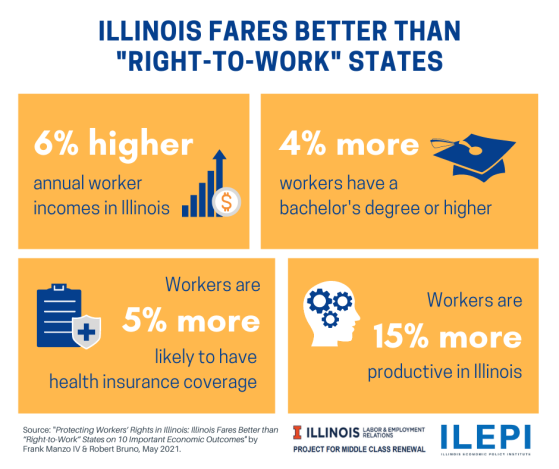| by Frank Manzo IV Study Comes as Biden Administration and Illinois Lawmakers Work to Strengthen Collective Bargaining La Grange, IL: States that have enacted so-called “right-to-work” laws underperform Illinois on a range of core economic metrics—including wages, income growth, workforce productivity, poverty, and workplace safety—according to a new study by the Illinois Economic Policy Institute (ILEPI) and Project for Middle Class Renewal (PMCR) at the University of Illinois at Urbana-Champaign. The study comes as Congress considers landmark legislation to strengthen labor unions across America, and as Illinois lawmakers consider placing a Constitutional Amendment before voters in 2022 that would permanently ban “right-to-work” laws. Read the report, Protecting Workers’ Rights in Illinois: Illinois Fares Better than “Right-to-Work” States on 10 Important Economic Outcomes here. “Right-to-work” laws do not affect an individual’s right to seek or accept gainful employment. Instead, they prohibit clauses in union contracts that ask all union-represented workers to share in the cost of collective bargaining. “By forcing unions to provide services to the workers they represent for free, ‘right-to-work’ laws reduce union resources, weakening their capacity to organize, negotiate on behalf of, and advocate for working families,” said ILEPI Policy Director and study co-author Frank Manzo IV. “This is borne out by the data, which shows that unionization rates in America’s ‘right-to-work’ states are at less than half the level of free collective-bargaining states, like Illinois. Accordingly, ‘right-to-work’ states are performing far worse on wages, health care coverage, income growth, poverty, and other core indicators.”  After controlling for a range of other observable factors such as geography, cost of living, immigration status, and other variables, researchers isolated the specific impacts of working in Illinois as opposed to “right-to-work” states.  “The data shows that working in Illinois translates to better economic and quality-of-life outcomes,” Manzo added. “It means 6% higher wages, 5% more health care coverage, 3% higher homeownership rates, and a more educated workforce with people having more time to enjoy the fruits of their labor. And while it translates into less income inequality, it still leaves CEOs earning as much as, or more than, they would have in a ‘right-to-work’ state.” While the contrasts between Illinois and “right-to-work” states are stark on many metrics, the differences were even more pronounced when comparing averages within “right-to-work” states to the average of all free collective-bargaining states (or non-right-to-work states), which includes Illinois. For example, economic growth in “right-to-work” states has lagged behind free collective-bargaining states by nearly 3% over the last decade. “While corporate surveys have long shown that ‘right-to-work’ laws do not factor into the re-location or hiring decisions that help drive economic growth, proponents of these measures have routinely claimed the opposite,” added PMCR Director, University of Illinois Professor, and study co-author Dr. Robert Bruno. “The data clearly shows that ‘right-to-work’ advocates are peddling a false narrative.” Though the U.S. Supreme Court imposed “right-to-work” conditions on state and local government employees nationally in its 2018 Janus v. AFSCME, Council 31 decision, five states enacted laws extending these conditions to private-sector workers over the last decade. Each year from 2013 to 2015, between 19 and 22 states considered “right-to-work” legislation. However, states have recently rejected “right-to-work” laws. “As more research exposes the truth about ‘right-to-work’ laws, even Republican-majority states like Montana and Missouri have rejected ‘right-to-work’ proposals, while existing ‘right-to-work’ states like West Virginia are publicly acknowledging that their laws have failed to deliver as promised,” Bruno added. With polling showing that record numbers of Americans are supportive of labor unions, efforts are also underway in both Congress and the Illinois Capitol to strengthen collective bargaining. A bi-partisan federal law that passed the U.S. House of Representatives in early 2020, called the Protecting the Right to Organize (PRO) Act, includes a provision that would repeal all state-level “right-to-work” laws. President Biden has also voiced support for this legislation. In Illinois, a bi-partisan effort is underway to place a Workers’ Rights Amendment to the state’s Constitution on the November 2022 ballot. The initiative would ban both local and state “right-to-work” measures in Illinois. “When workers have a stronger voice to bargain for wages, benefits, training, and safety standards, it produces long-term dividends both inside and outside the workplace,” Manzo concluded. “Today’s efforts to enhance the voices of workers would boost economic growth and increase access to good, family-sustaining jobs at a time when our state and nation are in dire need of both.”  The Illinois Economic Policy Institute (ILEPI) is a nonpartisan nonprofit organization which uses advanced statistics and the latest forecasting models to promote thoughtful economic growth for businesses and working families. The Project for Middle Class Renewal at the University of Illinois investigates the working conditions of workers in today’s economy to elevate public discourse aimed at reducing poverty, create more stable forms of employment, and promote middle-class jobs. |


